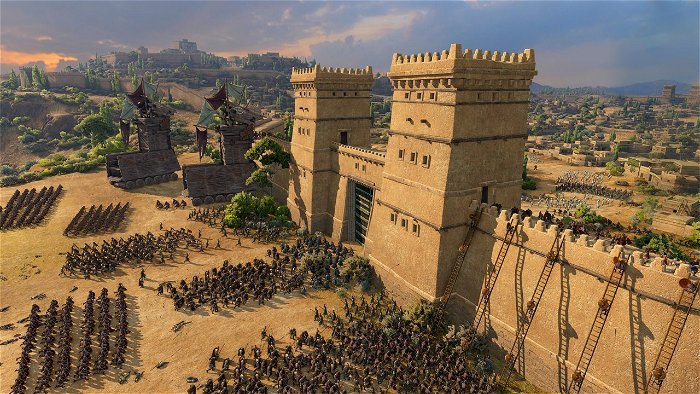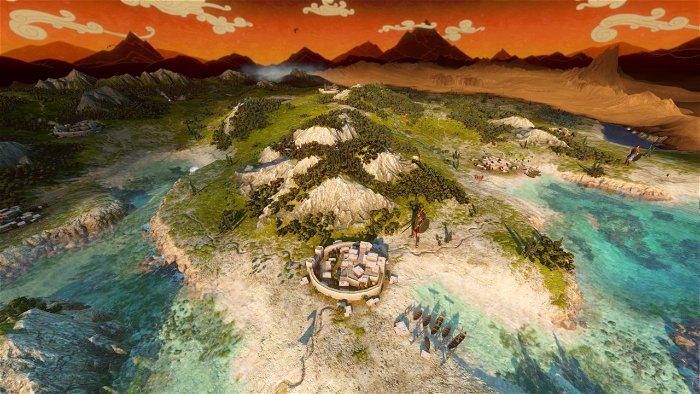Total War has become a series that, despite widely disparate settings, rarely shakes up its formula. Gameplay improvements are incremental with each new entry, as old problems never quite go away and new ones arise and fall with each cycle. Total War Saga’s are, in theory, meant to be more contained and experimental in comparison to the likes of Creative Assembly’s major historical titles or its take on Warhammer Fantasy. And while the latest, Total War Saga: Troy, does contain a few interesting turns on the franchise’s formula, it’s Total War’s all too familiar trappings that win out and hold back what is otherwise a fascinating game.
As the name suggests, Total War Saga: Troy is set in the mythical war between the Greeks and Trojans made famous in Homer’s Iliad. But whereas Total War: Three Kingdoms can be described as reality viewed through myth, Troy is myth viewed through reality. The Aegean Sea is depicted as a Bronze Age cradle of civilization where most buildings are rudimentary huts, where heroes like Achilles are not superhuman but merely powerful warriors, and where the Minotaur is not a half-man, half-bull, but simply a large human wearing a bull’s skull on his head.

Picking one of eight factions, of which there are four per side, you must conquer the world in either classic Total War style or through following a Homeric journey that sees your chosen leader embark on an epic quest. Regardless, Troy features the same mix of strategic management of your kingdom on a map and real-time tactical battles that can be found in any other entry in the franchise. And as familiar as this may be, Troy’s status as the earliest time period that a Total War game has been set in makes it more compelling in ways I didn’t anticipate.
For one, Bronze Age civilizations have not yet discovered the art of breeding warhorses that can carry armored soldiers to war. In other words, no cavalry apart from chariots. This would normally upend how one goes about engaging in war, but Troy instead opts to make infantry units more diverse than they’ve ever been before. Infantry are categorized into light, medium, and heavy, with multiple types of units in each that offer a wide variety of strategic possibilities. Units range from heavily armored and shielded spearman who excel at holding a position, to lightly swordsman who suspiciously feel as though they are as fast as horses and can flank easily, to a bunch of men wielding nothing more than a club.
More than just a block of people with a certain weapon type, many units have a wide array of abilities that allow them to hide or switch out weapons. For example, one unit can switch to javelins to throw at advancing soldiers before switching back to a sword and shield just as the enemy gets within melee distance. This is interesting in theory, and I want to see Creative Assembly explore this route in future games if they decide to take lessons from Troy and apply them elsewhere.

The same can also be said for the maps, which feature a larger amount of natural obstacles than I remember seeing in past games. That means that large stone formations can be used to create chokepoints, muddy ground can be used to slow down enemy armies, and tall grass can be used to hide a pack of skirmishers. Considering that flanking also plays a much larger role in shutting down enemy units if used successfully, the maps create greater tactical variety than would otherwise be possible with the infantry focused armies.
Yet the AI prevents this from happening. Long a marker by which Total War games thrive or falter, Troy’s AI is responsive and uses proper strategy until the moment battles begin. Across several difficulties, I found that the AI all too frequently abandons all thought once an enemy unit is near them, launching soldiers in large clumps that are all too easy to break down provided you have a decent army. Battles turn into a large, chaotic scrum that are easy to take advantage of as a result because the AI rarely reacted to what I was doing after its units were engaged. Occasionally, a battle would be gripping and tense as I made full use of the diverse units and abilities I had at my disposal — but these were rare.
In contrast to the disappointing AI, the overarching campaign is more successful. Managing your cities, technology, and diplomatic relations is as straightforward as past Total War games. But how you pay for it is a different matter entirely. Troy features five different resources to keep track of and develop in order to recruit new units, heroes, and construct building. Food, wood, stone, bronze, and gold can all be gathered at specialized settlements, some of which only have a limited supply to harvest in the first place. Managing resources, not just gold, adds an engaging new layer to managing your faction, as it forms the basis for how you’ll prioritize war targets, how you trade with factions, and how you’ll build your armies.

Outside of new resources, Troy adds Divine Favour to the mix as you fight to earn the approval of various Greek gods. By constructing temples, organizing rituals, and spending resources on prayers and festivals, you’ll earn the favour of deities like Hera, Zeus, Apollo, etc. Apart from a handful of special units awarded if you heavily invest in a god, divine favour mainly provides passive bonuses to your units and armies. For example, earning Poseidon’s favour will result in faster travel on the ocean, while Ares would grant a boost to units’ charge stat in battle. Divine favour is a minor addition that is interesting to play around with, but it could stand to use a more engaging structure to make you feel like choosing one god over another is worthwhile.
And that’s what Total War Saga: Troy ultimately feels like: Interesting to play with, but lacking in aspects that would make it stand out further from its legacy. There are ideas here that deserve to be explored in full later, namely the depth to the infantry and resource collection. As a complete piece, however, there’s nothing that makes me either dislike Troy nor enjoy it in the same way that I’d enjoy Three Kingdoms or Warhammer 2. It’s a decent Total War game, and for me, that’s good enough.





